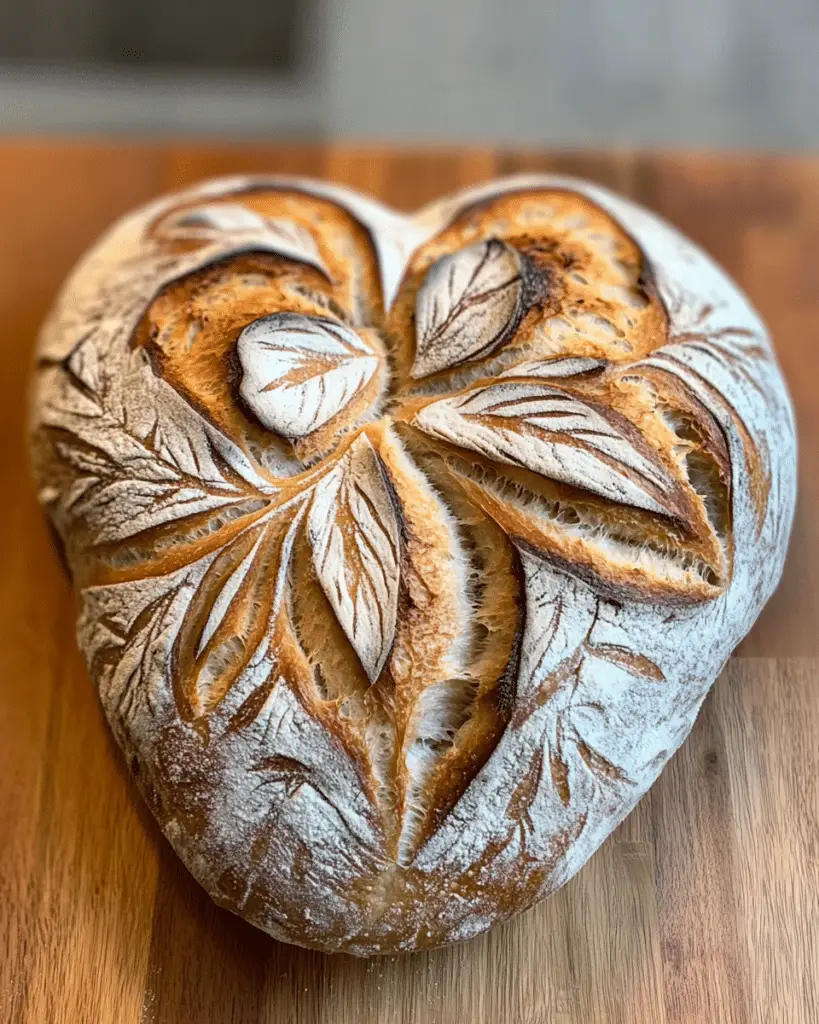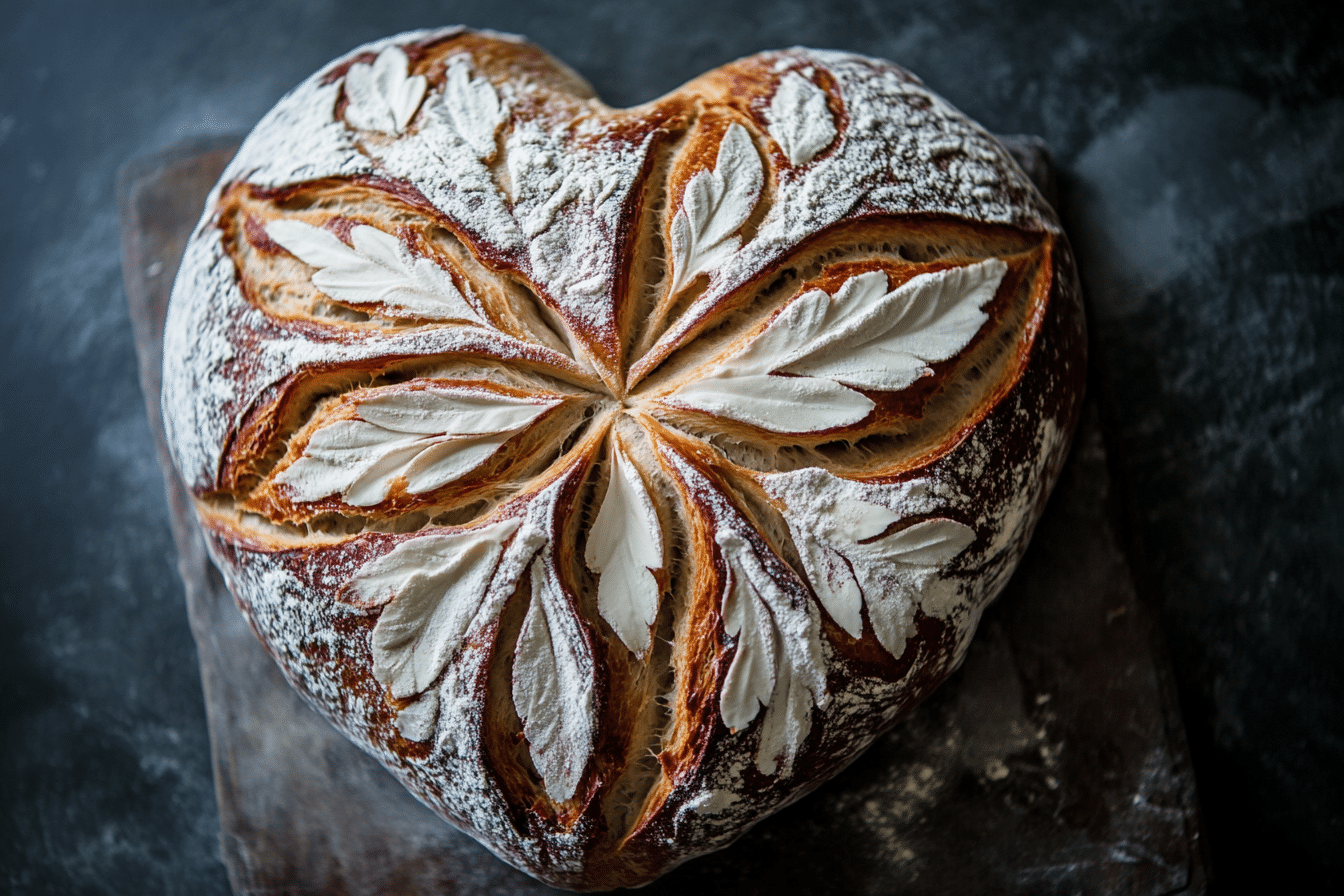Ah, sourdough—there’s something magical about that crusty, tangy bread that makes your heart skip a beat, and when it’s homemade, it’s a total game-changer. Whether you’re sharing it with loved ones or treating yourself, Valentine Sourdough is the kind of recipe that makes your kitchen smell like heaven. With just a handful of ingredients and a little patience, you can bake up the perfect loaf that’s crisp on the outside, soft and airy on the inside—trust me, you’re going to love this!
Why You’ll Love Valentine Sourdough
This recipe isn’t just about the ingredients—it’s about creating moments. Whether you’re baking for a special occasion, cozying up with a warm loaf, or impressing your friends, this sourdough bread fits every situation. Here’s why it’s a favorite:
Versatile
Perfect for everything from a casual dinner to a romantic night in. Picture yourself tearing off a piece of that warm, golden crust and savoring it with butter or your favorite spread—it’s the kind of simple pleasure you’ll come back to again and again.
Budget-Friendly
You don’t need fancy tools or expensive ingredients. Flour, water, salt, and starter—that’s all you need! It’s proof that the simplest things in life can be the best.
Quick and Easy
Okay, okay, I know sourdough is often seen as a project, but it’s easier than it sounds! With a bit of patience, you’ll have a homemade loaf that feels like a true accomplishment.
Customizable
Want to add seeds or herbs for extra flavor? Go for it! You can play around with different mix-ins, like roasted garlic or olives, to make this bread your own.
Crowd-Pleasing
This sourdough will have everyone asking for the recipe! There’s something about freshly baked bread that makes people gather around—it’s just irresistible.

Ingredients in Valentine Sourdough
Here’s the magic behind this loaf—it’s made with just a few pantry staples, but the result is absolutely incredible. Let’s break it down:
Sourdough Starter: This is the key to that signature tangy flavor and fluffy texture. If you don’t have one yet, don’t worry, you can easily make your own!
Flour: A mix of all-purpose flour and bread flour helps create the perfect dough with great structure.
Water: Room temperature water is the base to bring the dough together.
Salt: Essential for flavor, salt enhances the natural taste of the bread.
(Note: The full ingredients list, including measurements, is provided in the recipe card directly below.)
Instructions
Let’s dive into the steps to create this flavorful masterpiece:
Activate the Starter
In a large bowl, combine your sourdough starter with water. Stir it together until it’s fully mixed, then let it sit for about 30 minutes to activate.
Mix the Dough
Add flour and salt to the starter mixture. Stir until a shaggy dough forms, then knead the dough on a lightly floured surface until it becomes smooth and elastic (about 10 minutes).
First Rise
Place your dough in a greased bowl, cover it with a damp cloth, and let it rise for about 4-6 hours, or until it doubles in size.
Shape the Dough
Once the dough has risen, gently punch it down to release the air, then shape it into a round loaf.
Second Rise
Let the shaped dough rise again for about 1-2 hours, until it’s puffed up and ready to bake.
Preheat the Oven
While the dough is resting, preheat your oven to 475°F (245°C) and place a Dutch oven or heavy pot inside to heat up as well.
Bake the Bread
Carefully transfer your dough into the hot pot, score the top with a sharp knife to help it expand while baking, and cover with the lid. Bake for 20 minutes with the lid on, then remove the lid and bake for another 20-25 minutes, until the crust is golden brown.
Cool and Slice
Once baked, remove the bread from the oven and let it cool on a rack for at least 30 minutes before slicing—this step is crucial for getting that perfect texture.
Nutrition Facts
Servings: 12 slices
Calories per serving: 150
How to Serve Valentine Sourdough
This bread is perfect for many different occasions and can be served in several ways to complement your meal:
- With Butter: Spread a little salted butter on a warm slice—it’s the simple pleasures that make this bread irresistible.
- As Sandwiches: Use it to make a delicious sandwich with your favorite fillings like smoked salmon, cheese, or fresh veggies.
- With Soups or Stews: It’s the perfect accompaniment to a hearty bowl of soup or stew—dunk away!
- As a Side Dish: Serve it alongside roasted meats, salads, or pasta for an extra touch of warmth and comfort.
Pro tip: Slice it up, drizzle with olive oil, and toast it lightly for a crispy, golden snack.
Additional Tips
Here are a few extra tips to ensure you get the most out of your Valentine Sourdough:
- Starter Care: If you’re making your own starter, remember that patience is key! It can take 5-7 days to fully develop, but it’s totally worth it.
- Perfecting the Rise: If your dough isn’t rising well, make sure the room temperature is warm enough—sourdough loves warmth!
- Storage: Store your leftover bread in a paper bag to keep the crust crispy. For longer storage, wrap it in a clean towel and place it in a bread box.
- Double the Batch: This recipe freezes beautifully, so make an extra loaf and save it for later.
FAQ Section
Q1: Can I substitute the sourdough starter with store-bought yeast?
A1: While you can use store-bought yeast, it won’t give you the same depth of flavor as a sourdough starter. If you don’t have a starter, I recommend making one—it’s easy, and the flavor is unbeatable.
Q2: Can I make this recipe ahead of time?
A2: Yes! The dough can be prepared the night before and left to rise overnight in the fridge. Just let it come to room temperature before baking.
Q3: How do I store leftovers?
A3: Sourdough is best enjoyed fresh, but leftovers can be stored in a paper bag at room temperature for up to 3 days. You can also freeze it for up to a month!
Q4: Can I bake this without a Dutch oven?
A4: Yes! If you don’t have a Dutch oven, you can use a baking sheet and cover the bread with a bowl or large pot for the first part of baking. The key is to trap steam to help the bread rise.
Q5: How do I know when the bread is done baking?
A5: The bread should sound hollow when you tap the bottom. If you have a kitchen thermometer, the internal temperature should reach around 200°F (93°C).
Q6: Can I add other flavors to the dough?
A6: Absolutely! You can mix in herbs, olives, garlic, or even cheese to give the bread extra flavor.
Q7: Can I use whole wheat flour instead of white flour?
A7: Yes! You can substitute some of the white flour with whole wheat flour, but keep in mind that it will affect the texture and rise slightly.
Q8: How do I get that perfect sourdough tang?
A8: The longer you let the dough rise, the more tangy the flavor will become. If you like a more pronounced sourness, let it ferment a little longer!
Q9: How long does it take to make sourdough from scratch?
A9: The starter takes about 5-7 days to fully develop, but once your starter is ready, the actual bread-making process takes about 4-6 hours (with resting time in between).
Q10: Can I double the recipe?
A10: Absolutely! Just make sure you have a large enough bowl and baking pot to accommodate the larger dough.
Conclusion
Baking Valentine Sourdough is an experience that you’ll want to repeat time and time again. The crispy crust, soft interior, and tangy flavor make every bite a little moment of joy. Plus, there’s something so special about baking bread from scratch—whether it’s for yourself or sharing it with others, it’s bound to make your heart (and your kitchen) feel full.
So go ahead, give it a try. I promise you’ll fall in love with this bread—just like I did! Happy baking!
Print
Valentine Sourdough
- Prep Time: 6 hours (for levain)
- Cook Time: 45 minutes
- Total Time: 12-14 hours (including resting time)
- Yield: 1 loaf 1x
- Category: Bread, Baking
- Method: Oven
- Cuisine: American
- Diet: Vegetarian
Description
This sourdough bread has a lovely heart pattern, perfect for Valentine’s Day! The combination of bread and spelt flours gives it a unique flavor and texture. A great way to show you care with homemade bread.
Ingredients
- 450g bread flour
- 50g spelt flour
- 370g water
- 75g sourdough starter (at 100% hydration)
- 10g salt
Instructions
- Prepare the levain: About 6 hours before you plan to make the dough, prepare the levain. It should be very bubbly and active.
- Mix the dough: In the bowl of a KitchenAid mixer, add water and dissolve the sourdough starter. Stir briefly with a spatula, then add both flours and salt.
- Knead the dough: Attach the dough hook to the mixer and knead at low speed for 4 minutes. The dough should gain structure during this time.
- Bulk fermentation: Remove the dough from the mixer and place it in an oiled container. Cover with plastic wrap and allow it to ferment for 4 hours, folding every 45 minutes.
- Shape the dough: After 4 hours, shape the dough into a ball and place it seam-side up in a lightly floured banetton. Let it rest at room temperature for 1 hour, then transfer to the fridge for 8 to 12 hours.
- Preheat the oven: The next morning, preheat your oven to 450°F (232°C).
- Prepare for baking: Place three strings over the dough, spaced evenly, and press them lightly into the dough. Place a parchment paper on top and a flat baking sheet, then invert the dough from the banneton onto the baking sheet. Flour the dough and tie the strings on top. Score the dough in a heart pattern.
- Bake: Bake at 450°F for 45 minutes, covering the bread for the first 30 minutes to retain steam. After 30 minutes, remove the strings and bake for the remaining time.
- Cool: Allow the bread to cool completely on a rack before slicing.
Notes
- The dough needs to ferment in a cool environment overnight.
- If the strings stick to the dough, gently remove them after baking.
- This bread is best enjoyed fresh!
Nutrition
- Serving Size: 1 slice
- Calories: 180 kcal
- Sugar: 0g
- Sodium: 450mg
- Fat: 1g
- Saturated Fat: 0g
- Unsaturated Fat: 1g
- Trans Fat: 0g
- Carbohydrates: 36g
- Fiber: 2g
- Protein: 6g
- Cholesterol: 0mg

